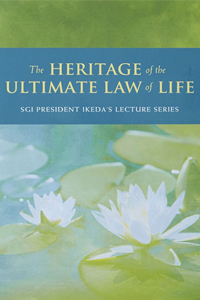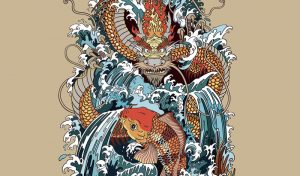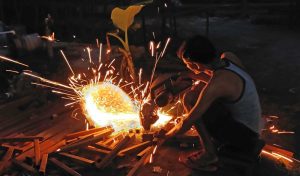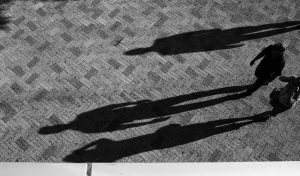Passage 1: “Hell Is the Land of Tranquil Light”
When he was alive, he was a Buddha in life, and now he is a Buddha in death. He is a Buddha in both life and death. This is what is meant by that most important doctrine called attaining Buddhahood in one’s present form.
—The Writings of Nichiren Daishonin, vol. 1, p. 456
Passage 2: “The Life Span of the Thus Come One”
The aspect or characteristics of the threefold world are birth, aging, sickness, and death. But if we look at birth and death in terms of their true nature, then there is no birth or death. And if there is no birth or death, then there is no ebb or flow. Not only do birth and death not exist. To look on birth and death with repulsion and try to escape from them is termed delusion, or a viewpoint of acquired enlightenment. Seeing and understanding the originally inherent nature of birth and death is termed awakening, or original enlightenment.
Now when Nichiren and his followers chant Nam-myoho-renge-kyo, they realize the originally inherent nature of birth and death, and the originally inherent nature of ebb and flow.
—The Record of the Orally Transmitted Teachings, p. 127
Passage 3: “The Heritage of the Ultimate Law of Life”
Myo represents death, and ho, life. Living beings that pass through the two phases of life and death are the entities of the Ten Worlds, or the entities of Myoho-renge-kyo.
T’ien-t’ai says that one should understand that living beings and their environments, and the causes and effects at work within them, are all the Law of renge (the lotus). Here “living beings and their environments” means the phenomena of life and death. Thus, it is clear that, where life and death exist, cause and effect, or the Law of the lotus, is at work.
Awakening to the Inherent Nature of Life and Death—Gaining True Hope and Freedom
The following is excerpted from The Heritage of the Ultimate Law of Life: SGI President Ikeda’s Lecture Series. In a passage of “The Heritage of the Ultimate Law of Life,” Nichiren Daishonin explains the profound relationship between “life and death” and “Myoho-renge-kyo.” It can be read as an expression of his inner realization that his life itself is Myoho-renge-kyo. It also clarifies the theoretical grounds for why Myoho-renge-kyo is the “ultimate Law of life and death.”
Life and Death Are Part of the Inherent Rhythm of the Mystic Law
Myo represents death, and ho, life. Living beings that pass through the two phases of life and death are the entities of the Ten Worlds, or the entities of Myoho-renge-kyo [literally, “or the lotus of the entity”].
T’ien-t’ai says that one should understand that living beings and their environments, and the causes and effects at work within them, are all the Law of renge (the lotus). Here “living beings and their environments” means the phenomena of life and death. Thus, it is clear that, where life and death exist, cause and effect, or the Law of the lotus, is at work.
The Great Teacher Dengyo states, “The two phases of life and death are the wonderful workings of one mind. The two ways of existence and nonexistence are the true functions of an inherently enlightened mind.” No phenomena—either heaven or earth, yin or yang, the sun or the moon, the five planets, or any of the worlds from hell to Buddhahood—are free from the two phases of life and death. Life and death are simply the two functions of Myoho-renge-kyo. In his Great Concentration and Insight, T’ien-t’ai says, “Arising is the arising of the essential nature of the Law, and extinction is the extinction of that nature.” Shakyamuni and Many Treasures, the two Buddhas, are also the two phases of life and death. (The Writings of Nichiren Daishonin, vol. 1, p. 216)
In “The Heritage of the Ultimate Law of Life,” Nichiren draws the distinction that myo (mystic) represents death and ho (law), life. Because ho indicates manifest phenomena, it corresponds to life that is manifested as individual living beings. Myo, on the other hand, indicating that which is mysterious or inscrutable, corresponds to death, reflecting the fact that the vast universe into which all life fuses at death is difficult to fathom. But the main point of this statement, I believe, is to show that the life and death of all living beings in the infinite tapestry of the universe are functions of the Mystic Law. (The Heritage of the Ultimate Law of Life: SGI President Ikeda’s Lecture Series, p. 23)
The Metaphor of the Ocean and Waves
The relationship between the Mystic Law and life and death could be described as being similar to a wave appearing on the surface of the ocean and then submerging back into the ocean again, wherein the ocean represents the Mystic Law, and the wave, an individual life or phenomenon. The pattern of waves arising from the ocean and then returning to it corresponds to the cycle of birth and death. It must be noted, however, that individual lives do not get swallowed up upon death in the ocean of the Mystic Law and disappear in the same way that a casual observer may see ordinary waves disappearing into the ocean.
If we consider that there are various currents flowing through the ocean not visible from the surface, the difference between life and death could be likened to that between surface waves and the undulating currents within the ocean’s depths. The life essence of an individual is certainly not extinguished at death. Life and death are simply the undulations of the Mystic Law itself. Undulations within the ocean’s depths appear on the surface as waves and then submerge again into the ocean, once more becoming invisible undulations. In the same way, a wave of life that manifests on the surface of the ocean of the Mystic Law will, at death, merge once more with that ocean and continue its unseen undulations. Then, when conditions are right, that life essence will appear again as a new wave. (Lecture Series, 23–24)
An Existence Originally Joyful, Pure and Bright
Next, Nichiren Daishonin says: “Living beings that pass through the two phases of life and death are the entities of the Ten Worlds” (WND-1, 216). This contains a very important point. The two aspects of life and death—which make up life in its totality—encompass the Ten Worlds, or ten potential states of life inherent in each individual being. This means that all living beings of the Ten Worlds are entities of the Mystic Law that embodies these two phenomena. Or put another way, the phenomena of life and death, inherent in the Mystic Law, are the true substance of the lives of all beings of the Ten Worlds.
• • •
Good friends; joyful, pure and bright; dwelling together harmoniously in freedom; who pledged to strive for the happiness of both themselves and others—this describes our original selves of time without beginning, free of all illusion; this describes the realm of time without beginning.
To recover this original self, this realm of time without beginning, we each need to be aware that our own life is an entity of the Mystic Law. And we have to realize that we ourselves possess the power to break free of the chain of causality that gives rise to illusion and leads to suffering. (Lecture Series, 24–25)
The Law of the Lotus, the Law of the Simultaneity of Cause and Effect
There are two levels to the principle of causality. The first is that of simple karmic retribution—receiving reward or punishment in accord with one’s actions. This way of thinking teaches that making good causes leads to happiness, joy and ease, while making bad causes leads to suffering, pain and misery. The second level goes beyond this former idea to reveal a still more fundamental principle of causality governing all life. Buddhism teaches that when we reveal the supreme world of Buddhahood inherent in our lives, we actualize the highest good and can thereby instantly establish a state of unshakable happiness. In other words, it is possible for us—as living beings of the nine worlds, bound by the causality of the three paths (earthly desires, karma and suffering)—to bring forth the effect or fruit of enlightenment by revealing our innate Buddhahood or Buddha nature.
This deeper level of causality taught in Buddhism differs from ordinary temporal cause and effect, or “general causality.” At work here is the principle of the simultaneity of cause and effect, which teaches that through a change in the depths of our own hearts or minds, we can bring forth our inherent Buddhahood, right here and now. (Lecture Series, 26)
Tapping the Great Life Force of the Universe in Our Own Lives
The cycle of birth, death and rebirth—the cycle of transmigration—is a strict causal law that no one can escape. This causality highlights how each individual is responsible for his or her own life, thereby offering a much greater sense of independence and freedom than the idea that the individual is helplessly at the mercy of an arbitrary destiny or fate bestowed by some transcendent, absolute being. But it ultimately leaves people feeling overwhelmed and oppressed by the massive weight of karma they have accumulated over countless existences.
This is where the causality of the Mystic Law comes in. Based on the principle that living beings possess all of the Ten Worlds, it clarifies how we can break free of the heavy weight of accumulated karma by transforming it at the most fundamental level of life itself. Each of us, regardless of what spiritual state we may presently be in, absolutely possesses in the depths of our lives the powerful state of Buddhahood overflowing with supreme wisdom. When we reveal this inner Buddhahood, we can surmount all obstacles. This is the working of “the Law of the lotus” (WND-1, 216)—the law of the simultaneity of cause and effect.
When we awaken to this reality, we can break through any hardship or adversity and positively open up and transform our destiny. This is how we can attain ultimate, indestructible freedom abounding with supreme autonomy. Also, when we are confident of the infinite power within us, an imperturbable hope is born in our hearts. Thus, when difficulties assail us, no matter how serious, we can see them as challenges through which we can demonstrate the power of the Mystic Law within us, and also as wonderful, sought-for opportunities that we should tackle head-on. When we approach things with this positive attitude and tenaciously triumph over each obstacle, we can develop and elevate our own state of life enormously and construct a truly invincible state of freedom. Myoho-renge-kyo is indeed the supreme teaching, bringing people true hope and inner freedom.
Our first Soka Gakkai president, Tsunesaburo Makiguchi, remarked: “The life force of every one of us without exception is a manifestation of the great life force of the universe. Accordingly, the great Law that is the fountainhead of the life force of all universal phenomena, which manifest as agents of that life force—including human beings, which do the same—is the Mystic Law and, as such, is the essence and the substance encompassing all principles governing life.”
When we tap the great fundamental life force of the universe inherent in our lives, we achieve a towering state of being in which we can summon up power as immense as the universe itself. (Lecture Series, 26–27)
All Universal Phenomena Are the Workings of Compassion
This towering state of life is certainly not governed by a selfish impulse that seeks only personal happiness. Rather, it gives rise to a spirit of mutual support and encouragement directed toward everyone realizing their full potential, and toward drawing forth and harmonizing each person’s individuality. To care for and encourage others is compassion—and compassion is a function that pervades the entire universe.
President Toda used to describe the universe as inherently expressing the workings of compassion. He wrote: “In the first place, the universe in its entirety is the substance of the Buddha, and all phenomena in the universe are the workings of compassion. Therefore, compassion is the inherent nature of the universe . . .
“Since the universe itself is compassion, that of course means that our daily activities naturally constitute the workings of compassion themselves. Because we lead privileged lives as human beings, we must not descend to the same level as animals or plants. Carrying out more exalted activities is the attitude of those truly dedicated to serving the Buddha …”
• • •
When we chant Nam-myoho-renge-kyo with the deep conviction that we are entities of the Mystic Law, the fundamental Law of the universe, we can bring forth the great life force of the Mystic Law, which is infused with wisdom and compassion. And we can use it to break through any painful difficulty or obstacle and establish a state of absolute happiness that nothing can destroy. If we continue on this path, then, when the moment of death finally comes, we will savor a state of tremendous inner peace and contentment that derives from maintaining a correct and steadfast attitude in faith. What this means is cherishing the firm conviction that “my life itself is the Mystic Law” and upholding a correct view of life and death based on the Middle Way, while rejecting the views of annihilation or permanence. Achieving a death of that sort is the supreme and ultimate goal of life. Here, both life and death are filled with joy. (Lecture Series, 27–28)

Order The Heritage of the Ultimate Law of Life: SGI President Ikeda’s Lecture Series, here.
You are reading {{ meterCount }} of {{ meterMax }} free premium articles





